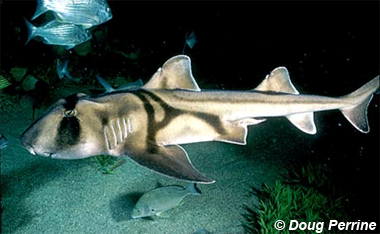
Heterodontus portusjacksoni
This medium size Australian shark has a blunt head with a small mouth and prominent crests above its eyes. It is usually a light gray brown, with black bands over its eyes and across its back in a harness shape. Unlike most sharks, the Port Jackson can eat and breathe at the same time, and they use their unique teeth to grind up crustaceans and mollusks. Average length is around 4.5 feet but some can grow as long as 5.5 feet.
Order – Heterodontiformes
Family – Heterodontidae
Genus – Heterodontus
Species – portusjacksoni
Common Names
Heterodontus portusjacksoni is most commonly known as the Port Jackson shark (English). The Port Jackson shark received its name after Port Jackson Australia, where it is commonly seen. Other English language names for this species include bullhead, oyster-crusher, tabbigaw, pigfish, pig, and horn shark. Other common names include australiansarvihai (Finnish), doggenhai (German), dormilón toro (Spanish), Port Jackson stierkophaai (Dutch), Port Jackson-haj (Danish), Portjacksonhaj (Swedish), and requin dormeur taureau (French).
Importance to Humans
The Port Jackson shark is of little importance to humans, since it is not used for food, and rarely targeted in sport fishing. Because of its slow moving nature during the day, the Port Jackson shark is not of great interest to fisherman. Typically, this shark is used for scientific research or caught as bycatch.
Danger to Humans
According to the International Shark Attack File, there are no confirmed attacks by Port Jackson sharks. Generally, Port Jackson sharks are considered to be harmless, however, if provoked they could pose a threat.
Conservation
The conservation status of Port Jackson is unknown. Recent studies suggest Port Jackson shark populations suffer from high embryonic mortality rates, and thus should be monitored closely to insure the populations are not being overfished as bycatch. The fact that Port Jackson sharks reach maturity later in life, along with the limited number of eggs produced each year, and high embryonic mortality rates could all contribute to a decrease in the population.
> Check the status of the Port Jackson Shark at the IUCN website.
The IUCN is a global union of states, governmental agencies, and non-governmental organizations in a partnership that assesses the conservation status of species.
Geographical Distribution
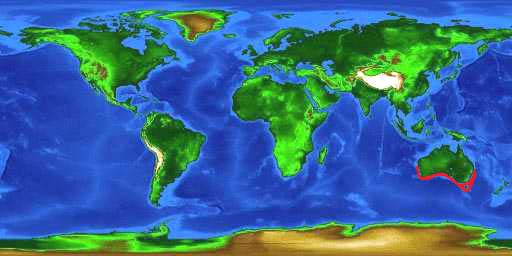
Port Jackson sharks are primarily found off the southern coast of Australia. While there have been reports of Port Jackson sharks being found off the northern coast of Australia, southern coast of Queensland, and off the coast of New Zealand, there is very little evidence that these populations exist.
Habitat
The Port Jackson shark is a nocturnal, bottom dwelling shark that is found in the temperate waters off of the southern half of Australia. Port Jackson sharks are found both close to shore and off the shelf in waters as deep as 902 feet (275 m). During the day they are found in flat areas with some shelter from currents (i.e. caves). Depending on the season, Port Jackson sharks migrate between ‘foraging refuges’ and ‘ovipositional refuges’. During the mating season, August – November, Port Jackson sharks are seen laying their eggs close to shore, and thus more neonates are seen in the shallows come hatching season. It is believed that this species has great spatial memory, and knows where other groups and resting sites occur. Thus if an individual is disturbed at one site it can quickly find another acceptable site within the region. There is some evidence that suggests that Port Jackson sharks are seen in groups segregated by gender and level of maturity.
Biology
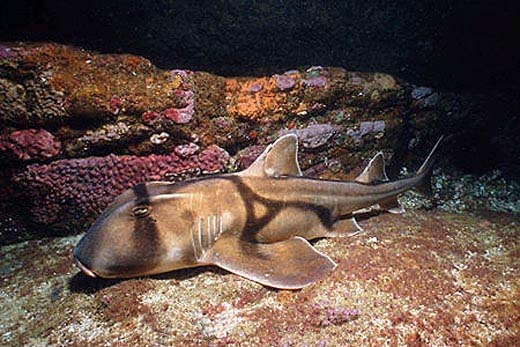
Distinctive Features
As a member of the Heterodontidae family, the Port Jackson shark displays some of the typical characteristics that make up the family, including a spine found in front of each of the dorsal fins. The Port Jackson shark also displays a blunt head, an anal fin, and large crests above its eyes. The most distinguishing feature of this species is the dark colored harness-like pattern along the top front and sides of its body. Other distinctive features noted by scientists include a small mouth, and nostrils that connect to the mouth through grooves.
The egg capsules are distinguishable by their double-helix, cone-like structure. The double helix flange wraps the capsule two to three times beginning with the broad end. Initially, the egg capsule is an olive green color but after
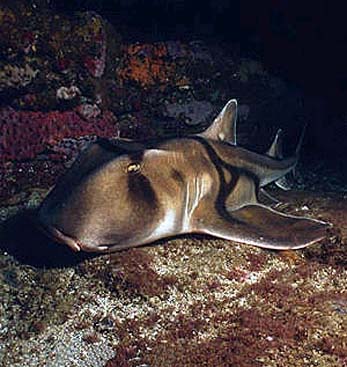
Coloration
Port Jackson sharks have been described as having grey, light brown, fawn, or whitish colored bodies. However, the distinguishing coloration on Port Jackson sharks is the dark black banding found on the back and sides of their bodies. There is a band that crosses over the face and usually passes right over the eyes. Then there is a harness shaped band that crosses over the backside before the first dorsal fin and continues across the pectoral fins and sides of these sharks. Scientists have also observed narrow dark stripes found on the back of Port Jackson sharks that begin at the first dorsal fin and continue to the caudal fin.
Dentition
This shark has a small mouth containing small, cuspidate teeth in the front and large, molar-like teeth in the back. The molar-like teeth found in the rear of the mouth are used to crush prey.
Denticles
The Port Jackson shark has large dermal denticles, aligned in a posterior direction. Their skin is often described as rough and very tough.
Size, Age, and Growth
Sexual maturity for females occurs when the individual is between 27.6 – 35.4 inches (70 90cm) total length. The size at which 50% of the population reaches maturity has been reported as 31.7 inches (80.5cm) in total length for females. Captive studies have suggested that the age of female maturity is between 11 and 14 years old. Males reach maturity within the size range of 21.7 – 27.6 inches (55-70cm) in total length, with 50% of the population reportedly reaching maturity between 22.9-23.3 inches (58.1-59.3cm). Based on captive studies, the suggested age of male maturity is 8-10 years old. Reportedly, Port Jackson sharks can live more than 30 years. Records indicate the largest Port Jackson shark was 65 inches (165cm) in total length. However, it is uncommon for Port Jackson sharks to grow more than 53.9 inches (137cm) in total length.
Food Habits
This species feeds primarily on echinoderms, crustaceans, mollusks, and some small fish. Sea urchins and large gastropod mollusks are noted in almost every study on the diets of Port Jackson sharks. Stomach contents are typically ground up too small for full identification, thus leading researchers to believe Port Jackson sharks grind their food thoroughly before swallowing. This is also supported with juvenile diets, since it has been noted that juveniles eat more soft-bodied animals, and contain less molar-like teeth.
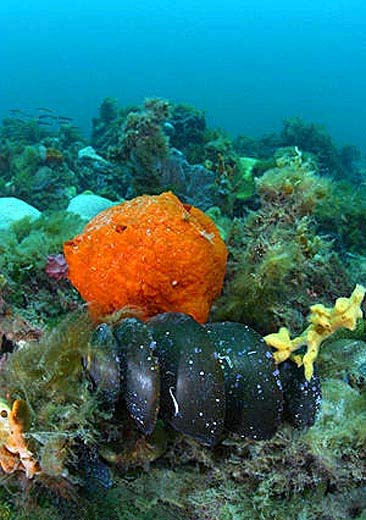
Reproduction
Port Jackson sharks are oviparous, meaning they lay egg capsules instead of giving live birth, and have an annual reproductive cycle. The Port Jackson shark breeding season lasts from late August to mid November, during which time a female will lay a pair of eggs every 10-14 days. Scientists have noted that a female can lay up to 16 eggs during each breeding season. An embryo develops for 10-11 months before hatching from its egg capsule completely. A typical Port Jackson shark hatchling (known as a neonate) is 7.1-8.7 inches (180-220mm) long in total length. Recent studies have suggested that egg capsules suffer 89.1% mortality, primarily from predation. Males reach peak sperm production around May, but females do not begin laying eggs until late August. Mating occurs some time prior to laying the eggs and the females store the sperm within their shell glands until ready to fertilize the eggs.
Predators
Not much is known about predators of Port Jackson sharks. Juveniles are more likely to become prey for other marine life, than the adults. There are some reports indicating adult male Port Jackson sharks prey upon Port Jackson shark egg capsules, however some speculate that those reports were cases of mistaken identity since crested horn sharks (Heterodontus galeatus) have been seen preying upon Port Jackson shark egg capsules on several occasions. There are some speculations that Port Jackson sharks could fall prey to larger sharks, such as the white shark or bluntnose sevengill shark.
Parasite
Numerous parasites have been reported both on and within Port Jackson sharks. Parasites found include copepods, nematodes, leeches, fish lice, cestodes, trematodes, and isopod larvae.
Taxonomy
In 1793 Meyer named this shark both Heterodontus portusjacksoni and Squalus portusjacksoni . Other names previously used for this shark include Squalus jacksoni Suckow, 1799, Squalus philippi Bloch & Schneider, 1801, Squalus philippinus Shaw, 1804, Squalus jacksonii Turton, 1806, Cestracion philippi Lesson, 1830, Cestracion heterodontus Sherrard, 1896, and Heterodontus bonaespei Ogilby, 1908 (Compagno 2001). However,Heterodontus portusjacksoni is the valid name used today. The family name Heterodontidae/genus nameHeterodontus comes from the Greek words “heteros”, meaning different, and “odont”, meaning teeth. The species name, portusjacksoni, refers to Port Jackson in Australia where this species is commonly observed.
Prepared by: Rebecca Sarah Thaler